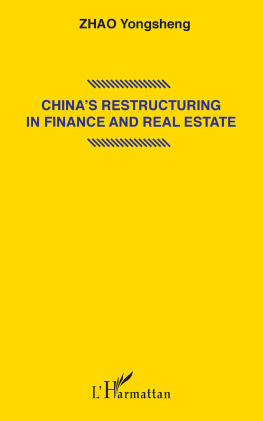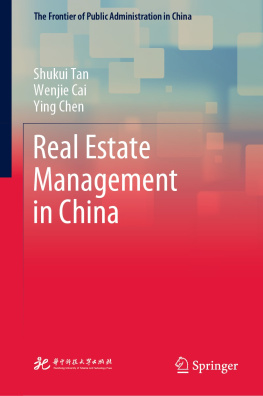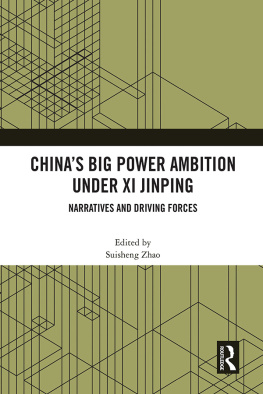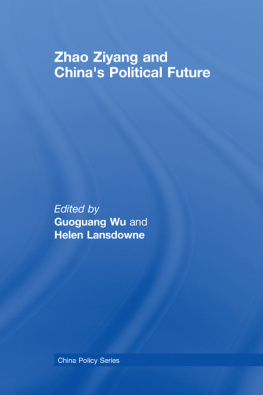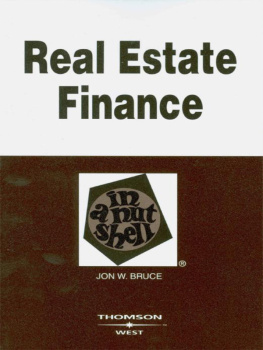INTRODUCTION
Finance and real estate that this book aims to analyze are two significant variables for the economic growth of an emerging economy like China during its four decades reform and opening-up.
Chapter One will analyze Chinas restructuring in finance : banking system reforms, credit system reforms, and the Chinese governments efforts to adopt the WTO-oriented reforms, including opening the banking and financial sector to foreign competition, and the restructuring of non-performing loans or assetsa thorny issue for Chinese State-owned banks and enterprises.
Chapter Two will focus on Chinas restructuring in real estate. After reviewing the complicated real estate reform from an old system to a new mechanism, the urban redevelopment as a special housing reform will be analyzed. Real estate in China is a controversial sector, which is a pillar of growth but faces a risky bubble. In fact, different economic and financial variables have contributed to the expansion of the Chinese housing market.
Finally, policy recommendations will be advanced.
S ECTION 1 B ANKING S YSTEM R ESTRUCTURING
1. Banking System Before Reform
The PBOC, as the center of cash, credit and settlement, delivered cash and granted credit. The cash held by urban residents and SOEs were to be deposited to the PBOC, and the settlement among different public sectors should also be made through the PBOC.
Although specialized banks had been founded under the PBOC like the Agricultural Bank of China (ABC), the Bank of China (BOC) and China Construction Bank (CCB), they were not independent. The PBOC has a virtually monopoly of banking activities in China, and these specialized banks exist only as a department of the PBOC or the Ministry of Finance.
It is not difficult for us to see that during the 30 years since the PRC was established to the start of the reform, from 1949-1978, Chinas banking system had undergone changes in terms of institutional setting. However, the all-in-one banking system had not been fundamentally changed by the reform and opening-up.
The banking systems main mission was to provide turnover capital (liquid funds) to enterprises. Consistent with the aforementioned situation, national savings at that time came mainly from the government. In 1978, government savings made up 15.5% of the GNP while accumulated residential savings only accounted for 6%. Moreover, the former was much more important than the latter. For the most part between 1962 and 1978, there was a slight surplus in government expenses minus disbursement for investment based on budget, and between 1958 and 1978, the Chinese government had neither internal nor external debt.
Before the reform and opening-up, the function of financial intermediation was limited in resource allocation as most investments were directly disbursed by the government instead of by the banking system. This limited banking activity was monopolized by the all-in-one banking system led by the PBOC. The result was the absence of a financial market, and almost no other financial assets other than banking savings.
2. Banking System At The Beginning of Reform
By the end of 1991, the PBOC had, aside from its headquarters in Beijing, 44 first-level branches in provinces and big cities, more than 400 second-level branches (between province and county) and about 2,000 subsidiary institutions at the county level. At that time, the PBOC had more than 166,000 employees.
As a central bank, the PBOC was a government administrative institution under the direct guidance of the State Council. Its main missions are to establish macro monetary policies, control monetary supply, regulate interest and exchange rates, exert the cashbox influence of the central government, regulate financial market and formulate comprehensive credit plans.
As an official representative of China, the PBOC has represented the government in international organizations such as the International Monetary Fund (IMF) since 1980 and Asian Development Bank (ADB) since 1985. In addition, the PBOC established under its guidance the State Administration of Foreign Exchange (SAFE) which is a government institution specializing in foreign currency control and management.
Aside from the PBOC, the Chinese banking system is composed of specialized banks and commercial banks. China has 4 State-owned specialized banksthe Industrial and Commercial Bank of China (ICBC), which initially specialized in lending to the industrial sector, the Agricultural Bank of China (ABC) for agricultural lending and rural development, the China Construction Bank (CCB) to develop large-scale and long-term infrastructure projects, and the Bank of China (BOC) for foreign exchange activities and to finance imports and exports.
The Rural Credit Cooperatives (RCCs) were the rural financial institutions which belong to the ABC and under its guidance. Tightly linked to the CCB, the China Investment Banks (CIB) primary function is to arrange international financing mainly from the World Bank. China created several comprehensive commercial banks, including national banks like the Bank of Communications (BOCOM) and Citic Industrial Bank (CITICIB), and regional banks like Shenzhen Merchant Bank, Fujian Industrial Bank, Guangdong Development Bank and Shanghai Pudong Bank.
During the reform period, specialized banks were restructured and new commercial banks and financial institutions were also set up. The primary mission of specialized banks is to run commercial banking activities in its specific fields. At the same time, they are required to provide policy-directed credit and to implement economic policies based on government instructions. Here is a brief discussion on Chinas major banks and financial institutions.
Seven Banks
The Industrial and Commercial Bank of China (ICBC) was established on January 1, 1984 simultaneously with the PBOC. Its primary mission is to take over the commercial bank of the PBOC so that the latter can operate as a central bank. The ICBC collects savings from different sources and provides commercial banking services to urban residents, enterprises and other working units. The ICBC is the predominant source of State-owned and collectivity-owned enterprises loans as turnover capital, to settle transactions of enterprises and other working units, and to supervise the firms financial activities.



